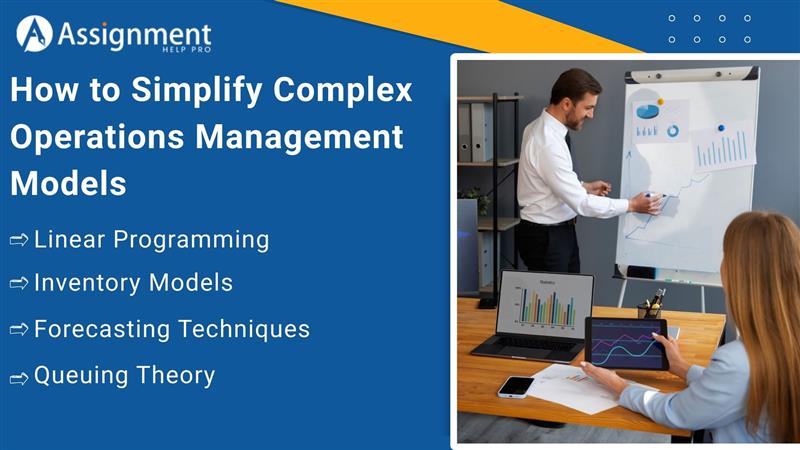If you are struggling with complex operations management models, simplify them by breaking problems into smaller parts, selecting the right approach, and using tools like Excel or Python. You can also get operations management assignment help from experts to understand tough concepts easily and boost your confidence in solving real-world problems.
Operations management is a key part of every successful business. It is where raw materials and resources are turned into products or services efficiently. No matter whether it is making goods or offering services, operations management focuses on using resources wisely, keeping costs low, maintaining quality, and giving customers what they need. The goals of operations management may seem simple, but the methods used to reach them can be quite complex.
If you are a management student, then for your assignments, you will be asked to simplify complex models in operations management. Often, many students and professionals seek online assignment help from operations management experts when they find it hard to understand the models, theories, and tools involved. Instead of that, you can also read this blog and understand everything about operations management and the ways to simplify the complex models involved in it.
An Overview of Operations Management
Operations management is all about planning, organizing, and managing the processes that turn resources into products or services. It involves taking care of both daily tasks and long-term strategies to make things more efficient, improve quality, and respond better to customer needs.
The main goals of operations management are to
- Reduce costs
- Increase productivity
- Deliver products or services on time
- Keep quality high
- Make sure operations support the company’s overall goals
Many industries, such as manufacturing, transport, retail, healthcare, hotels, and tech companies, depend on operations management. Specifically, people who work in operations management handle many tasks, like managing supply chains, controlling inventory, predicting demand, scheduling work, checking quality, and improving processes. But to manage all these activities effectively, different operation models are necessary.
The operation models are tools that often involve mathematics or specific concepts and are used to support better decision-making.
Common Issues with Complex Operation Models
Operations models are meant to make real-world processes easier to understand. Typically, operation models, such as linear programming, queuing theory, inventory models, and forecasting techniques, require knowledge of advanced math, statistics, and sometimes even coding. They can be difficult to grasp because they are not only complex but also quite abstract. Moreover, adding real-world data and constraints to it can make them even harder for you to follow. Hence, it is essential to have a clear and structured approach.
If you want to easily understand a complex model, then focus on these questions
- What problem is the model trying to solve?
- What information or data is needed?
- How does the model process the data?
- What decisions or outcomes does the model provide?
Make sure to improve your comprehension of the most common operations management models and learn how to make them easier to work with. This will help you prepare your operations management assignments well.
How to Simplify Complex Operations Management Models
When you pursue an MBA or any other degree related to management courses, you will be asked to submit operations management assignments on simplifying complex models. If you are unsure how to deal with them, take a look below. Here, we have shared some complex operations management models and the effective ways to simplify them
Linear Programming
Linear programming (LP) is a method you can use to find the best outcome, like maximizing profit or minimizing costs, while working within certain limits.
It might feel complex for you because it involves goals, constraints, inequalities, and sometimes several variables. Also, visualizing problems with more than two variables can be tricky.
To simplify it,
- Start by clearly defining what you want to maximize or minimize.
- Identify all the constraints, like resources, capacity, or deadlines.
- Write everything out in mathematical form.
- Use tools like Excel Solver or Python’s PuLP to solve larger problems instead of doing the math by hand.
Once you work through a few real-world examples, understanding and solving LP problems will become much easier.
Inventory Models
Inventory management focuses on keeping enough stock to meet customer demand without holding too much, which can cost extra. Some common inventory models you will come across are Economic Order Quantity (EOQ), Just-In-Time (JIT), and the Newsvendor Model.
These models can feel complicated because they often rely on assumptions like constant demand or lead times, which don’t always match real situations. They also involve tricky calculations like square roots and probabilities.
To understand it easily,
- Break down the costs into ordering, holding, and shortage costs.
- Learn when to use each model. EOQ works well if demand is steady, while the Newsvendor suits one-time purchases.
- Use diagrams and flowcharts to visualize the flow of the supply and demand.
- Run simulations to see how changes in demand impact your costs.
Knowing how inventory works will help you avoid running out of stock or having too much, both of which can be expensive.
Forecasting Techniques
Forecasting is an important part of planning. It will help you estimate future demand, set budgets, and manage resources wisely. Some common forecasting methods include moving average, exponential smoothing, regression analysis, and ARIMA.
It might look complex because there are so many options, and choosing the right one depends on your data. Furthermore, you will need to look for patterns like trends, seasonality, or random changes.
To simplify it,
- Start by looking at your data to see if there are any clear patterns.
- Try simple methods like moving average before using more advanced techniques.
- Split your data into two parts. One to build the model and another to test it.
- Use tools like Excel, R, or Python to handle the math and save time.
Forecasting doesn’t need to be perfect. So, your goal should be to make good decisions based on reasonable predictions and not to be 100% accurate.
Queuing Theory
Queuing theory will help you understand and improve systems where people or data wait in line, such as in hospitals, banks, or online services.
It can seem hard at first because it uses probability concepts like Poisson and exponential distributions, along with service and arrival rates that involve complex formulas
To make it easier,
- Start with simple models like M/M/1, which represents one service point with random arrivals and service times.
- Think about real-life situations—like waiting in line at a coffee shop compared to an emergency room.
- Draw process diagrams to see how people or tasks move through the system.
- Use tools like MATLAB or Python’s queuing libraries to simulate more complex systems without doing math by hand.
Queuing theory is very useful when you want to reduce waiting times and make services run more smoothly for customers.
Strategic Approach for Operations Management Assignments
Is it challenging for you to do your operations management assignments? If yes, then follow these strategies
- Make sure you understand what the question is asking and what decision needs to be made
- Choose the model that best fits the problem instead of using everything at once
- Use tools like Excel or software to handle tough calculations easily
- Break the problem into smaller parts and solve them step by step
- Look at the results and explain what they mean in a real business situation
In case you still experience difficulties in handling your academic work, without hesitation, get management assignment help from experts online.
Wrapping Up
Operations management uses many models to help improve efficiency and support better decisions. These models can seem complex at first, but with the right approach and the right tools suggested in this blog, you can learn to understand them easily. In case you still experience difficulties in improving your comprehension, utilize our operations management assignment help services. The management experts from our team will assist you in simplifying the complex operation management models effectively. Also, they will guide you in accurately finishing all your academic tasks on operations management concepts on time and enhancing your grades.





